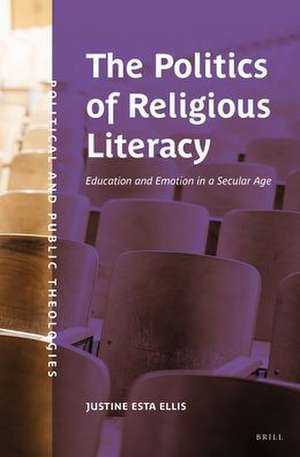The Politics of Religious Literacy: Education and Emotion in a Secular Age: Political and Public Theologies, cartea 2
Autor Justine Ellisen Limba Engleză Paperback – 9 noi 2022
Preț: 337.93 lei
Nou
Puncte Express: 507
Preț estimativ în valută:
64.67€ • 67.34$ • 54.66£
64.67€ • 67.34$ • 54.66£
Carte indisponibilă temporar
Doresc să fiu notificat când acest titlu va fi disponibil:
Se trimite...
Preluare comenzi: 021 569.72.76
Specificații
ISBN-13: 9789004512931
ISBN-10: 9004512934
Pagini: 236
Dimensiuni: 155 x 235 mm
Greutate: 0 kg
Editura: Brill
Colecția Brill
Seria Political and Public Theologies
ISBN-10: 9004512934
Pagini: 236
Dimensiuni: 155 x 235 mm
Greutate: 0 kg
Editura: Brill
Colecția Brill
Seria Political and Public Theologies
Notă biografică
Justine Esta Ellis, DPhil (2020), University of Oxford, is an Academic Visitor at the University of Oxford. Previously, she was an American Council of Learned Societies (ACLS) postdoctoral Leading Edge Fellow. She has published articles on religion and policy in journals, including The Journal of Law, Culture and the Humanities and Postscripts: The Journal of Sacred Texts and Contemporary Worlds.
Cuprins
Introduction: Defining the “Religious” in Religious Literacy
From Secularization to the Secular Body
Religious Literacy in Context
Looking Ahead
1 The Rise of Religious Literacy
1Values
2Content Knowledge
3Skills
4Critical Responses
5Conclusion
2 Public Sphere, Private Choice: Religious Literacy and Public Reason
1Secularity 3 and Religious Voluntarism
2Taking Religion Seriously
3Inclusion in the Public Sphere
4The Standard of Democratic Discourse
5Conclusion
3 Religious Literacy and Its Limits: Liberalism, Affect, and Pedagogy
1“In the Service of Democracy”: Secularity, Civics, and Liberal Education
2“From Head to Heart”: Affect, Autonomy, and the Materialist Shift
3“The Integrity of the Teacher”: Pedagogy, Neutrality, and Secular Subjectivity
4Conclusion
4 Tolerance and Its Discontents: Managing Offense in Religious Literacy Discourse
1“Allergic to Controversy”: Tolerance, Civility, and Religious Offence in Public Schools
2“A Crisis of Civility”: Critical Reconsiderations of Tolerance and Civil Discourse
3“Vigorous-Yet-Respectful Critique”: Religious Literacy’s Reframing of Tolerance Discourse
4The Limits of the Law: Does Religious Literacy Step in Where the Law Ends?
5“Respect Your Neighbor”: Agonistic Respect, Deep Equality, and the Self-Regulation Trap
6Conclusion
5 The “Post-compliance” Moment: Religious Literacy in the Workplace
1Ernst & Young (EY) – Coexist House
2The Tanenbaum Center for Interreligious Understanding
3The “Post-compliance” Moment
4Conclusion
6 “Labels Can Be a Barrier”: Religious Literacy and the Question of Category
1“Religion is Not a Native Category”: Critical Religion and World Religions
2Nonreligion as the New Frontier of Interreligious Dialogue and the Seeming Solution of Worldviews
3Conclusion
Conclusion: Reforming Religious Literacy
In Search of the Secular Student Body
Classroom Critiques
Teaching the Secular
Affective Pedagogies
Liberal Habits
Conclusion
Bibliography
Index
From Secularization to the Secular Body
Religious Literacy in Context
Looking Ahead
1 The Rise of Religious Literacy
1Values
2Content Knowledge
3Skills
4Critical Responses
5Conclusion
2 Public Sphere, Private Choice: Religious Literacy and Public Reason
1Secularity 3 and Religious Voluntarism
2Taking Religion Seriously
3Inclusion in the Public Sphere
4The Standard of Democratic Discourse
5Conclusion
3 Religious Literacy and Its Limits: Liberalism, Affect, and Pedagogy
1“In the Service of Democracy”: Secularity, Civics, and Liberal Education
2“From Head to Heart”: Affect, Autonomy, and the Materialist Shift
3“The Integrity of the Teacher”: Pedagogy, Neutrality, and Secular Subjectivity
4Conclusion
4 Tolerance and Its Discontents: Managing Offense in Religious Literacy Discourse
1“Allergic to Controversy”: Tolerance, Civility, and Religious Offence in Public Schools
2“A Crisis of Civility”: Critical Reconsiderations of Tolerance and Civil Discourse
3“Vigorous-Yet-Respectful Critique”: Religious Literacy’s Reframing of Tolerance Discourse
4The Limits of the Law: Does Religious Literacy Step in Where the Law Ends?
5“Respect Your Neighbor”: Agonistic Respect, Deep Equality, and the Self-Regulation Trap
6Conclusion
5 The “Post-compliance” Moment: Religious Literacy in the Workplace
1Ernst & Young (EY) – Coexist House
2The Tanenbaum Center for Interreligious Understanding
3The “Post-compliance” Moment
4Conclusion
6 “Labels Can Be a Barrier”: Religious Literacy and the Question of Category
1“Religion is Not a Native Category”: Critical Religion and World Religions
2Nonreligion as the New Frontier of Interreligious Dialogue and the Seeming Solution of Worldviews
3Conclusion
Conclusion: Reforming Religious Literacy
In Search of the Secular Student Body
Classroom Critiques
Teaching the Secular
Affective Pedagogies
Liberal Habits
Conclusion
Bibliography
Index



